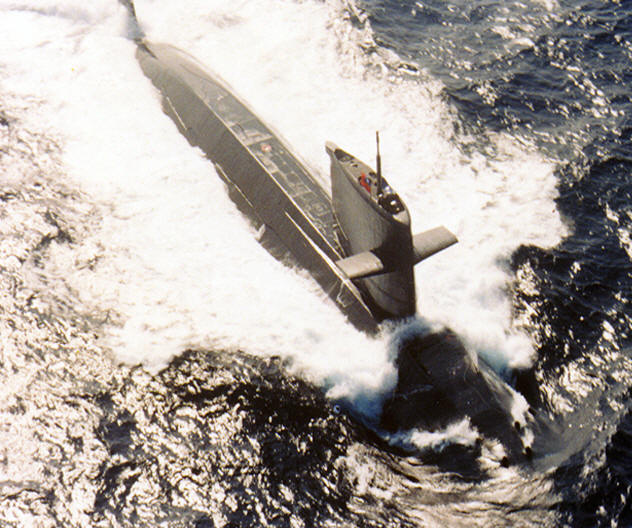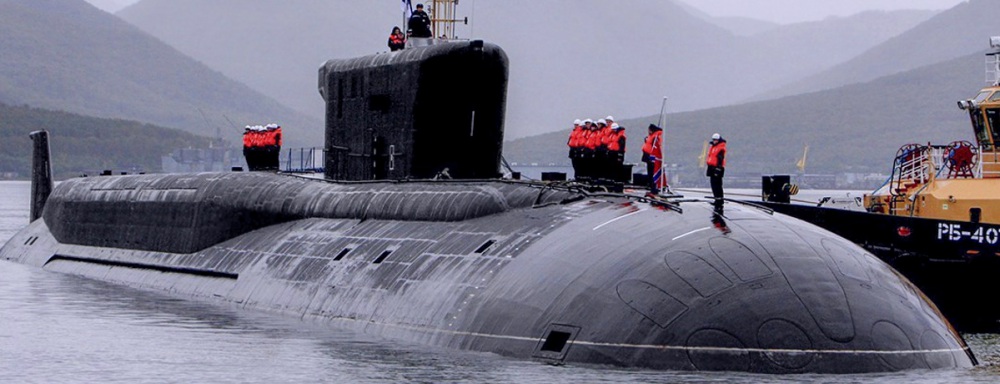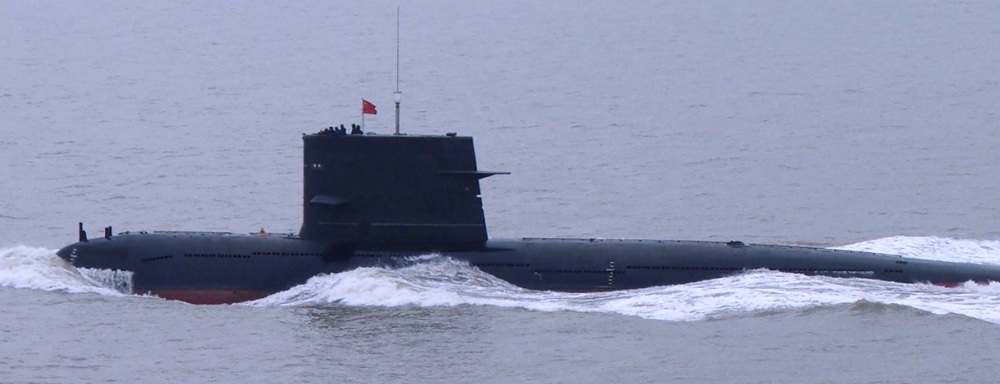The Taiwanese Navy currently operates two Hai Shih-class submarines and two Chien Lung-Class submarines based at the Tsoying Naval Base in Kaohsiung.1

Capabilities at a Glance
Total Submarines in Fleet: 4
- Ballistic Missile Submarines (SSBNs): 0
- Nuclear-Powered attack submarines (SSNs): 0
- Diesel-electric attack submarines (SSKs): 4
- Air-independent propulsion (AIP) enabled: 0
Submarines
History
In the 1980s, the Taiwanese Navy acquired two Hai Lung vessels from the Netherlands: the Hai Lung (Sea Dragon) 793 and the Hai Hu (Sea Tiger) 794. Taiwan then embarked on a journey to procure new diesel submarines but struggled to complete this mission due to Chinese pressure.2 In 2001, U.S. President George W. Bush offered Taiwan a foreign military sales package that included an offer for eight diesel-electric submarines.3 As the United States had not produced diesel-electric submarines since the 1950s, the administration suggested that U.S. shipyards would produce the submarines off European-licensed designs. Fearing Chinese retaliation, European states refused to license production for any U.S. diesel-electric submarines destined for Taiwan.4
In response, the U.S. Department of Defense suggested that Taiwan buy refurbished submarines. While the Italian Ministry of Defense agreed to sell eight Sauro-class boats, Taiwan preferred to acquire new vessels. In 2004, the U.S. agreed to build diesel-electric submarines for Taiwan from a clean-sheet design at the Ingalls Shipyard in Pascagoula, Mississippi.5 However, this effort quickly stalled. In 2010, the Obama Administration announced a new foreign military sales package for Taiwan that did not include the eight diesel-electric submarines.6
Modernization and Current Capabilities
With significant constraints on foreign acquisition, Taiwan has explored building submarines indigenously. In 1996, Taiwan acquired design information on Norway’s Ula-class and Argentina’s Santa Cruz-class (TR 1700) submarines.7 Moreover, Taiwan retains a significant amount of technical information about its Hai Lung-class (improved Zwaardvis-design) submarines which it purchased from the Netherlands in 1987.8
In 2005, a cross-ministry task force discovered that Taiwan’s China Shipbuilding Corporation (CSBC) “almost” had the capability to build submarines. This task force noted, however, that the “provision of submarine blueprints and submarine weapons system [from the United States] are two prerequisites” to full-scale production.9 In 2014, the Taiwanese Navy formalized the Taiwanese Indigenous Defense Submarines (IDS) program to natively develop eight submarines. August 4th 2016, China Shipbuilding Corporation formed a submarine development center to begin the process of indigenously building submarines.10 The first of these vessels is expected to be completed by 2025.11 In 2018 Taiwan began searching for foreign support and has received support from France, Japan, and the US in their indigenous submarine project.12
In 2016, the Taiwanese Ministry of Defense began a life-extension upgrade for its Hai Lung-class submarines, extending their service life by fifteen years.13 In 2017, the Trump Administration approved a 425 million USD sale of advanced torpedoes to Taiwan as part of a larger Foreign Military Sales [FMS] package.14 In 2018, the U.S. State Department approved a license to sell submarine-related subsystems to Taiwan which would aid in Taiwan’s plan to domestically produce submarines.15 In January 2019, China’s Foreign Ministry spokesperson declared their country’s dissatisfaction with the U.S. defense technology transfers to Taiwan.16
Tawian’s new submarines will be diesel-electric attack submarines modeled after Japan’s Sōryū-Class SSKs. Japan is providing engineers and marines to oversee the project in Taiwan.17 The submarines will also include US combat management technology and have Dutch influence as well.18 The submarines are expected to be about have a displacement of 2500 tons and be 70 meters long.19 The entire initiative is projected to cost around 10 billion USD.20 The first submarine is expected to be ready for ocean testing in late 2022, and all of the submarines will be ready for service in 2025.21
Ship Biographies
Hai Shih-Class
Taiwan possesses two Hai Shih-class attack submarines. The ROCS Hai Shih (SS-791) was a Tench-Class submarine while the ROCS Hai Pao (SS-792) was a Balao-class submarine. Both of these vessels were transferred from U.S. Navy to Taiwan in 1973. These submarines are 94 meters long with an 8.3-meter-wide beam and can travel up to 8.75 knots when submerged. Hai Shih-class vessels have a maximum patrol endurance of 75 days with a submerged endurance of 48 hours. Weapons systems include 6 bow and 4 stern torpedo tubes capable of firing 533mm torpedoes.22
Chien Lung-Class
Taiwan possesses two Chien Lung-class attack submarines. These boats are modified version of Dutch Zwaardvis-class vessels. These submarines are 66.9 meters long with an 8.4-meter-wide beam and can travel up to 20 knots when submerged. Their weapons systems are capable of launching up to 28 torpedoes from their six 533mm torpedo tubes.23
Import and Export Behavior
Imports
After its acquisition of two Chien Lung-class vessels from the Netherlands in 1987, Taiwan has been unable to purchase submarines due to Chinese pressure.24 However Taiwan has received foreign support for their indigenous submarine manufacturing project.25
Exports
Taiwan does not export submarines.
Explore the Collection
Australia Submarine Capabilities
Brazil Submarine Capabilities
Chile Submarine Capabilities
China Submarine Capabilities
France Submarine Capabilities
Germany Submarine Capabilities
Greece Submarine Capabilities
India Submarine Capabilities
Indonesia Submarine Capabilities
Iran Submarine Capabilities
Israel Submarine Capabilities
Italy Submarine Capabilities
Japan Submarine Capabilities
Malaysia Submarine Capabilities
Netherlands Submarine Capabilities
North Korea Submarine Capabilities
Pakistan Submarine Capabilities
Russia Submarine Capabilities
Singapore Submarine Capabilities
South Korea Submarine Capabilities
Sweden Submarine Capabilities
Your are currently on
Taiwan Submarine Capabilities
United States Submarine Capabilities
Submarine Detection and Monitoring: Open-Source Tools and Technologies
Stay Informed
Sign up for our newsletter to get the latest on nuclear and biological threats.
More on

Russia Submarine Capabilities
Overview of Russia's submarine capabilities and import-export behavior.
United States Submarine Capabilities
Overview of the United States' submarine capabilities and import-export behavior.

China Submarine Capabilities
A highlight of global trends in the sale and acquisition of diesel- and nuclear-powered submarines by country with capabilities, imports and exports. (CNS)
Glossary
- SSBN
- Ship, Submersible, Ballistic, Nuclear: A hull classification for a submarine capable of launching a ballistic missile. The "N", or nuclear, refers to the ship's propulsion system. SSBN's are generally reserved for strategic vessels, as most submarine launched ballistic missiles carry nuclear payloads. A non-strategic vessel carries the designation SSN, or attack submarine.
- Diesel-electric submarine
- Diesel-electric submarine: A submarine with a diesel-electric transmission. Diesel-electric transmissions require access to oxygen for the diesel generator to charge the submarine’s batteries or drive the motor. This type of submarine is thus louder and must surface more frequently than a nuclear-powered submarine. A diesel-electric submarine can fire conventional cruise missiles against land targets, and in theory, can also carry nuclear-tipped cruise missiles. Diesel-electric submarines are significantly cheaper to build and purchase than nuclear-powered vessels, which makes them the vessel of choice for smaller navies.
- Air Independent Propulsion Technology (AIP)
- Air Independent Propulsion Technology (AIP): A propulsion system that uses liquid (or compressed) oxygen or hydrogen fuel cells, thereby allowing submarines to stay submerged for longer periods without the need for external sources of oxygen. This increased endurance also increases a submarine’s survivability.
Sources
- Stephen Saunders, Jane’s Fighting Ships 2002-2003 (Coulsdon: Jane’s Information Group, 2003); Hsu Shao-hsuan, “Submarine Situation Dire: Analyst,” The Taipei Times, 17 January 2011, www.taipeitimes.com.
- Wade Boese, “Bush Approves Major Arms Deal to Taiwan, Defers to Aegis Sale,” Arms Control Association, May 2001, www.armscontrol.org.
- Anton La Guardia and Hannah Cleaver, “Europeans Vow to Stop America Selling Submarines,” The Daily Telegraph, 26 April 2001, in Lexis-Nexis Academic Universe, www.lexisnexis.com.
- J. Michael Cole, “Taiwan Giving Up on U.S. Subs, Eyeing Local Plan: Analyst,” Taipei Times, 15 December 2011, www.taipeitimes.com; Wendell Minnick, “Submarine Decisions Show Lack of Creativity,” Taipei Times, 16 October 2004, in Taiwan Security Research Website, taiwansecurity.org.
- Sharon Behn, “U.S. to Build 8 Subs in Deal with Taiwan,” Washington Times, 29 September 2004, in Lexis-Nexis Academic Universe, www.lexis-nexis.com.
- Michael Ashby and Jeff Abramson, “U.S.-Taiwan Arms Deal Angers China,” Arms Control Today, March 2010.
- “Submarine Forces, Taiwan,” Jane’s Underwater Warfare Systems, 16 June 2011.
- Rich Chang, “Agencies at Odds over Submarines,” Taipei Times, 15 April 2005, www.taipeitimes.com.
- J. Michael Cole, “Navy to Embark on Submarine Program,” Taipei Times, 21 February 2012, www.taipeitimes.com.
- Wendell Minnick, “Taiwan Establishes Submarine Development Center,” Defense News, 3 August 2016, www.defensenews.com.
- Wu Taijing, “Taiwan Breaks Ground on Submarine Shipyard to Counter China,” AP News, 9 May 2019, www.apnews.com.
- Franz-Stefan Gady, “India, Japan to Submit Design Proposals for Taiwan's New Indigenous Submarine,” The Diplomat, 12 July 2018, https://thediplomat.com.
- Wendell Minnick, “Taiwan Moves Forward on Sub Upgrades,” Defense News, 4 April 2016, defensenews.com.
- Defense Security Cooperation Agency, “Press Release: Taipei Economic and Cultural Representative Office (TECRO) in the United States – MK 52 Lightweight Torpedo (LWT) Conversion Kits,” Department of Defense, Transmittal No. 16-68, 29 June 2017; Defense Security Cooperation Agency, “Press Release: Taipei Economic and Cultural Representative Office (TECRO) in the United States – MK 48 Mod 6AT Heavyweight Torpedo (HWT),” Department of Defense, Transmittal No. 16-69, 29 June 2017.
- Mike Yeo, “US State Department OKs License for Submarine Tech Sales to Taiwan,” Defense News, 9 April 2018, www.defensenews.com.
- Duncan DeAeth, “China worries over Taiwan’s submarine program, implores US, other nations not to provide tech” Taiwan News, 15 January 2019, www.taiwannews.com.
- Lawrence Chung, “Taiwan offers glimpse of home-built submarine designed to deter Beijing,” South China Morning Post, 9 May 2019, www.scmp.com
- Franz-Stefan Gady, “Taiwan Unveils Model of Indigenously-Designed Diesel-Electric Attack Submarine,” The Diplomat, 9 May 2019, https://thediplomat.com.
- Sally Jensen, “Travel to Hong Kong or Macau restricted for Taiwan submarine personnel,” Taiwan News, 28 October 2019, www.taiwannews.com.tw.
- Ralph Jennings, “Taiwan breaks ground to build its own submarines,” Los Angeles Times, 9 May 2019, www.latimes.com.
- Rojoef Manuel, “Taiwan’s First Indigenous Submarine Launch Scheduled in September 2023,” The Defense Post, 15 July 2022, www.thedefensepost.com.
- Paul R. Yarnall, “Tench Class Submarines,” NavSource Naval History, accessed 29 January 2021, www.navsource.org.
- “Zwaardvis Class Submarine,” Seaforces.org, accessed 9 August 2019.
- T’ang Sheng, “Mainland strengthens prowess of submarines to deter ‘Taiwan Independence’ forces,” Ching Pao, 1 September 2002.
- Rojoef Manuel, “Taiwan’s First Indigenous Submarine Launch Scheduled in September 2023,” The Defense Post, 15 July 2022, www.thedefensepost.com.
